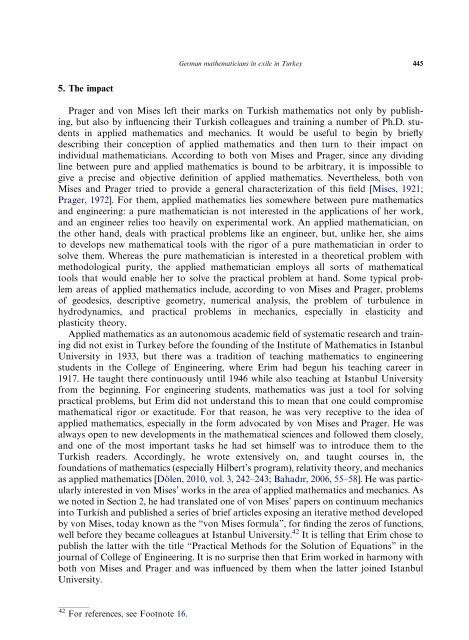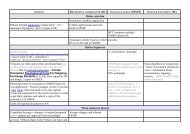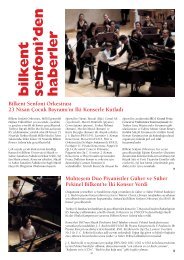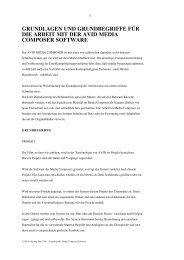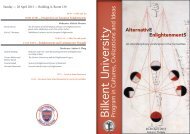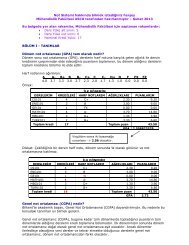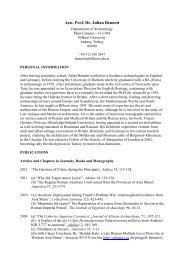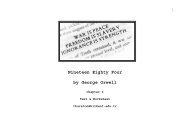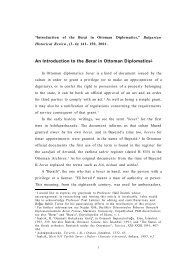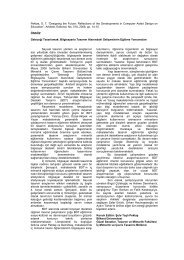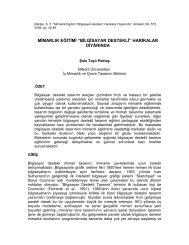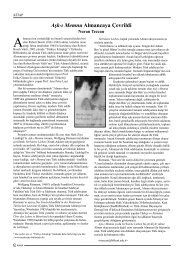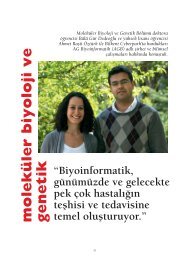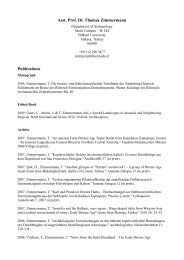German mathematicians in exile in Turkey ... - Bilkent University
German mathematicians in exile in Turkey ... - Bilkent University
German mathematicians in exile in Turkey ... - Bilkent University
Create successful ePaper yourself
Turn your PDF publications into a flip-book with our unique Google optimized e-Paper software.
5. The impact<br />
Prager and von Mises left their marks on Turkish mathematics not only by publish<strong>in</strong>g,<br />
but also by <strong>in</strong>fluenc<strong>in</strong>g their Turkish colleagues and tra<strong>in</strong><strong>in</strong>g a number of Ph.D. students<br />
<strong>in</strong> applied mathematics and mechanics. It would be useful to beg<strong>in</strong> by briefly<br />
describ<strong>in</strong>g their conception of applied mathematics and then turn to their impact on<br />
<strong>in</strong>dividual <strong>mathematicians</strong>. Accord<strong>in</strong>g to both von Mises and Prager, s<strong>in</strong>ce any divid<strong>in</strong>g<br />
l<strong>in</strong>e between pure and applied mathematics is bound to be arbitrary, it is impossible to<br />
give a precise and objective def<strong>in</strong>ition of applied mathematics. Nevertheless, both von<br />
Mises and Prager tried to provide a general characterization of this field [Mises, 1921;<br />
Prager, 1972]. For them, applied mathematics lies somewhere between pure mathematics<br />
and eng<strong>in</strong>eer<strong>in</strong>g: a pure mathematician is not <strong>in</strong>terested <strong>in</strong> the applications of her work,<br />
and an eng<strong>in</strong>eer relies too heavily on experimental work. An applied mathematician, on<br />
the other hand, deals with practical problems like an eng<strong>in</strong>eer, but, unlike her, she aims<br />
to develops new mathematical tools with the rigor of a pure mathematician <strong>in</strong> order to<br />
solve them. Whereas the pure mathematician is <strong>in</strong>terested <strong>in</strong> a theoretical problem with<br />
methodological purity, the applied mathematician employs all sorts of mathematical<br />
tools that would enable her to solve the practical problem at hand. Some typical problem<br />
areas of applied mathematics <strong>in</strong>clude, accord<strong>in</strong>g to von Mises and Prager, problems<br />
of geodesics, descriptive geometry, numerical analysis, the problem of turbulence <strong>in</strong><br />
hydrodynamics, and practical problems <strong>in</strong> mechanics, especially <strong>in</strong> elasticity and<br />
plasticity theory.<br />
Applied mathematics as an autonomous academic field of systematic research and tra<strong>in</strong><strong>in</strong>g<br />
did not exist <strong>in</strong> <strong>Turkey</strong> before the found<strong>in</strong>g of the Institute of Mathematics <strong>in</strong> Istanbul<br />
<strong>University</strong> <strong>in</strong> 1933, but there was a tradition of teach<strong>in</strong>g mathematics to eng<strong>in</strong>eer<strong>in</strong>g<br />
students <strong>in</strong> the College of Eng<strong>in</strong>eer<strong>in</strong>g, where Erim had begun his teach<strong>in</strong>g career <strong>in</strong><br />
1917. He taught there cont<strong>in</strong>uously until 1946 while also teach<strong>in</strong>g at Istanbul <strong>University</strong><br />
from the beg<strong>in</strong>n<strong>in</strong>g. For eng<strong>in</strong>eer<strong>in</strong>g students, mathematics was just a tool for solv<strong>in</strong>g<br />
practical problems, but Erim did not understand this to mean that one could compromise<br />
mathematical rigor or exactitude. For that reason, he was very receptive to the idea of<br />
applied mathematics, especially <strong>in</strong> the form advocated by von Mises and Prager. He was<br />
always open to new developments <strong>in</strong> the mathematical sciences and followed them closely,<br />
and one of the most important tasks he had set himself was to <strong>in</strong>troduce them to the<br />
Turkish readers. Accord<strong>in</strong>gly, he wrote extensively on, and taught courses <strong>in</strong>, the<br />
foundations of mathematics (especially Hilbert’s program), relativity theory, and mechanics<br />
as applied mathematics [Dölen, 2010, vol. 3, 242–243; Bahadır, 2006, 55–58]. He was particularly<br />
<strong>in</strong>terested <strong>in</strong> von Mises’ works <strong>in</strong> the area of applied mathematics and mechanics. As<br />
we noted <strong>in</strong> Section 2, he had translated one of von Mises’ papers on cont<strong>in</strong>uum mechanics<br />
<strong>in</strong>to Turkish and published a series of brief articles expos<strong>in</strong>g an iterative method developed<br />
by von Mises, today known as the “von Mises formula”, for f<strong>in</strong>d<strong>in</strong>g the zeros of functions,<br />
well before they became colleagues at Istanbul <strong>University</strong>. 42 It is tell<strong>in</strong>g that Erim chose to<br />
publish the latter with the title “Practical Methods for the Solution of Equations” <strong>in</strong> the<br />
journal of College of Eng<strong>in</strong>eer<strong>in</strong>g. It is no surprise then that Erim worked <strong>in</strong> harmony with<br />
both von Mises and Prager and was <strong>in</strong>fluenced by them when the latter jo<strong>in</strong>ed Istanbul<br />
<strong>University</strong>.<br />
42 For references, see Footnote 16.<br />
<strong>German</strong> <strong>mathematicians</strong> <strong>in</strong> <strong>exile</strong> <strong>in</strong> <strong>Turkey</strong> 445


